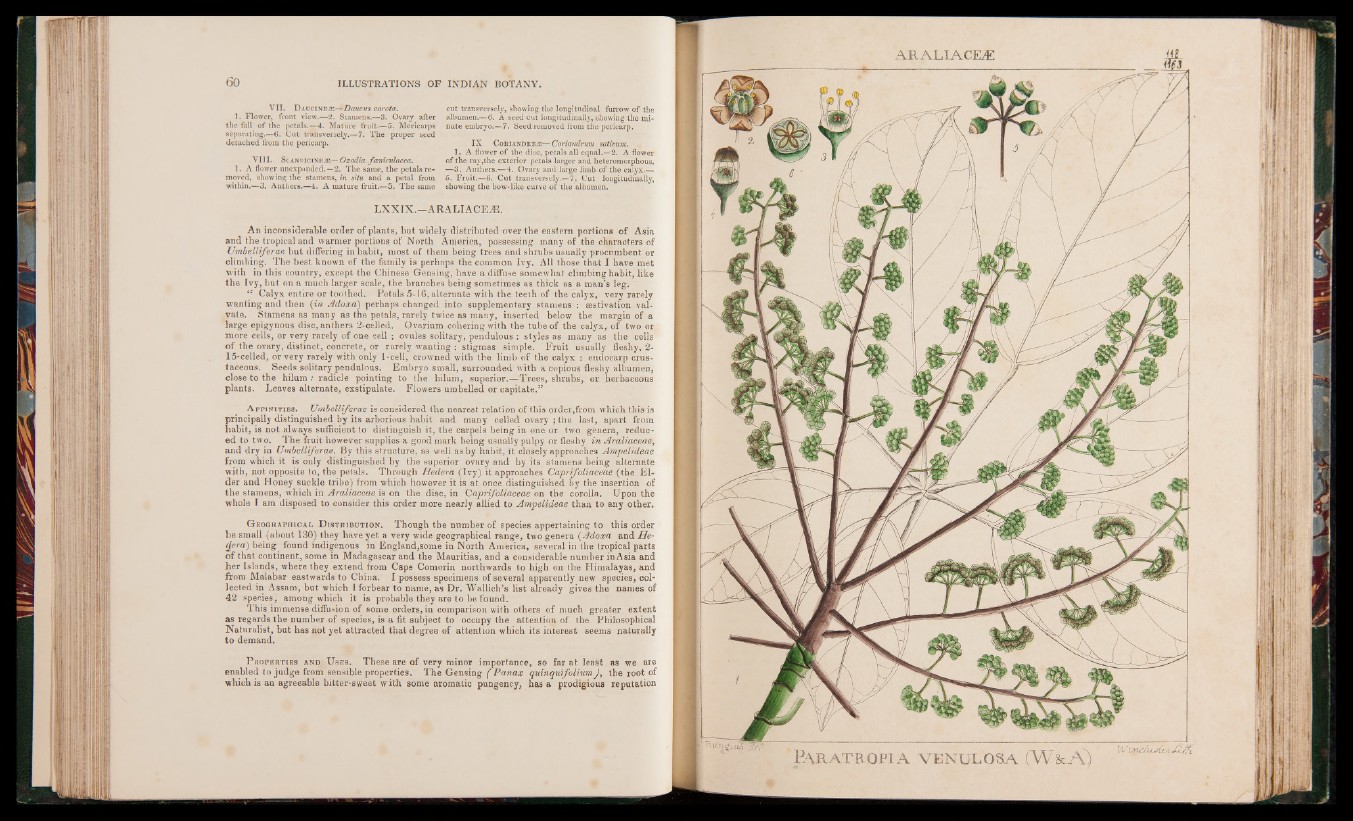
VII. Daucineje—D a u c v s carota.
1. Flower, front view.—2. Stamens.—3. Ovary after
the fall of the petals.—4. Mature fruit.—5. Mericarps
separating.—6. Cut transversely.—7. The proper seed
detached from the pericarp.
VIII. ScanDiciNBiE— Ozodici feenicvlacea.
1. A flower unexpanded.—2. The same, the petals removed,
showing the stamens, in situ and a petal from
within.—3. Anthers.—4. A mature fruit.—5. The same
cut transversely, showing the longitudinal furrow o f the
albumen.—6. A seed cut longitudinally, showing the mi.
nute embryo.—7. Seed removed from the pericarp.
IX CoriANDREAS—Coriandrum sativum.
1. A flower of the disc, petals all equal.—2. A flower
o f the ray,the exterior petals larger and heteromorphous.
—3. Anthers.—4. Ovary and large limb o f the calyx.—
5. Fruit.—6. Cut transversely.—7. Cut longitudinally,
showing the bow-like curve of the albumen.
LXXIX.—ARALIACEA3.
An inconsiderable order of plants, but widely distributed over the eastern portions of Asia
and the tropical and warmer portions of North America, possessing many of the characters of
ümbelliferae but differing inhabit, most of them being trees and shrubs usually procumbent or
climbing. The best known of the family is perhaps the common Ivy. All those that I have met
with in this country, except the Chinese Gensing, have a diffuse somewhat climbing habit, like
the Ivy, but on a much larger scale, the branches being sometimes as thick as a man’s leg.
“ Calyx entire or toothed. Petals 5- 16, alternate with the teeth of the calyx, very rarely
wanting and then (in Adoxa) perhaps changed into supplementary stamens : sestivation val-
vate. Stamens as many as the petals, rarely twice as many, inserted below the margin of a
large epigynous disc, anthers 2-celled. Ovarium cohering with the tube of the calyx, of two or
more cells, or very rarely of one cell : ovules solitary, pendulous : styles as many as the cells
of the ovary, distinct, concrete, or rarely wanting : stigmas simple. Fruit usually fleshy, 2-
15-celled, or very rarely with only 1-cell, crowned with the limb of the calyx : endocarp crus-
taceous. Seeds solitary pendulous. Embryo small, surrounded with a copious fleshy albumen,
close to the hilum : radicle pointing to the hilum, superior.—Trees, shrubs, or herbaceous
plants. Leaves alternate, exstipulate. Flowers umbelled or capitate.”
A ffinities. Ümbelliferae is considered the nearest relation of this order,from which this is
principally distinguished by its arborious habit and many celled ovary ; the last, apart from
habit, is not always sufficient to distinguish it, the carpels being in one or two genera, reduced
to two. The fruit however supplies a good mark being usually pulpy or fleshy in Araliaceae,
and dry in ümbelliferae. By this structure, as well as by habit, it closely approaches Ampelideae
from which it is only distinguished by the superior ovary and by its stamens being alternate
with, not opposite to, the petals. Through Hedera (Ivy) it approaches Caprifoliaceae (the Elder
and Honey suckle tribe) from which however it is at once distinguished by the insertion of
the stamens, which in Araliaceae is on the disc, in Caprifoliaceae on the corolla. Upon the
whole I am disposed to consider this order more nearly allied to Ampelideae than to any other.
G eographical D istribution. Though the number of species appertaining to this order
be small (about 130) they have yet a very wide geographical range, two genera (Adoxa and He-
<£era) being found indigenous in England,some in North America, several in the tropical parts
of that continent, some in Madagascar and the Mauritias, and a considerable number inAsia and
her Islands, where they extend from Cape Comorin northwards to high on the FIimalayas, and
from Malabar eastwards to China. I possess specimens of several apparently new species, collected
in Assam, but which I forbear to name, as Dr. Wallich’s list already gives the names of
42 species, among which it is probable they are to be found.
This immense diffusion of some orders, in comparison with others of much greater extent
as regards the number of species, is a fit subject to occupy the attention of the Philosophical
Naturalist, but has not yet attracted that degree of attention which its interest seems naturally
to demand.
P roperties and Uses. These are of very minor importance, so far at least as we are
enabled to judge from sensible properties. The Gensing ( Panax q u in q u ifo liu m the root of
which is an agreeable bitter-sweet with some aromatic pungency, has a prodigious reputation
W J-L/k Paratropia venulosa (W&A)